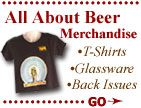
| ||||
| AAB Departments |
| ...Beer Features |
| ...Beer Talk |
| ...Pull Up A Stool! |
| ...What's Brewing |
| ...Beer Travelers |
| ...Stylistically Speaking |
| ...Beer & Food |
| ...Homebrewing |
| ...Collectibles |
| ...Marketplace |
| Beer Lovers' Resources |
| ...World Beer Festival |
| ...Brew Cruise Info |
| ...AAB Merchandise |
| ...AAB Bookstore |
| ...Beer Links |
| About the Magazine |
| ...Subscription Info |
| ...Retail the Magazine |
| ...Wholesaler Program |
| ...Advertising Info |
| ...Contact AAB |

|
Collectables
Collect Your Own Bottle
England’s Alexander Newell is credited with bottling the first beer. He did not own a brewery; he just liked to fish and drink. He would have the local tavern fill a used medicine bottle with his favorite ale, then bury the bottle in the mud on the riverbank or tie it off to dangle in the water. This allowed him to enjoy a cool one while he fished. Newell’s container was more along the lines of the modern day growler.
Actually, we owe the advent of bottle beer to Louis Pasteur, whose work with yeast, steam, and basic science enabled beer to travel beyond the local market. Another catalyst was the development of a pure yeast strain by Emil Christian Hansen at the Carlsberg brewery in Copenhagen, Denmark. These two innovators would revolutionize how beer could be packaged and distributed.
In America before the War Between the States, beer bottles were made of black glass crudely molded in a three-piece fashion. Packaged beer was not widely distributed until after the war. Some of the earliest bottles were made from pottery (crockery) and had the brewery’s name stamped onto them. Some had the name stamped on the bottle before it was glazed and fired. These bottles were corked and then topped with foil and a wire bale.
Following the Civil War, the quality and speed of glass manufacturing improved tenfold. Various breweries embossed their bottles with their names and logos. This not only aided in the quick return to the proper bottler, but it also prevented the capture and re-labeling of one brewery’s beer by some rogue organization. Anheuser-Busch was the first brewery to enter this cottage industry, purchasing railroad cars and shipping bottled lagers all across the United States.
When bottling began, breweries--under government mandate--contracted with a bottling company to package their beer. The bottler could not be attached to the brewery and had to be separated from the brewery by a street. Taxes had to be paid on the beer, measured by the package leaving the brewery. The 31-gallon US barrel, holding the kegged brew, became the standard unit of measurement. By 1890, pipelines were permitted. A meter was installed in the pipe and a government employee was assigned to monitor the flow.
Today’s "longneck" bottle really came into its own around 1910. Canned beer began in 1935 and, shortly after, the throwaway bottle arrived on the market. The twist-off cap came onto the scene in the 1950s.
After World War II, when can production was put back online, a number of glass manufacturers reintroduced the stubby one-way or "no-deposit" bottles. These designs used less glass and occupied less space in the refrigerator. Some breweries even advertised these "glass cans" for their conveniences. After years of returnable bottles, scrap drives and other war efforts, advertisers promoted disposable items as a reward for winning the war. This was the advent of the throwaway society.
Many breweries have patented and trademarked various bottle styles, such as the skittle-shaped bottle of Orval and the swing-top, tapered bottle used by Grolsch. Michelob and Carlsberg have used ornate bottles over the years. Innovations like built-in bottle openers, Styrofoam insulation, and embossings have also made the bottle a marketing tool.
With the success of microbreweries and imported beers in the past few years, the demand for bottled beer has been on the increase, and thankfully, so has collecting and recycling.
Beer Dave Gausepohl has collected breweriana since 1974 and has a personal collection of over 400,000 items. He has visited over 1,000 breweries and tasted well over 10,000 different brews from the world over.








